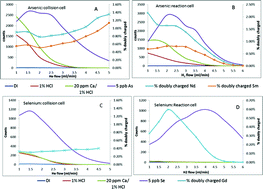Advantages of reaction cell ICP-MS on doubly charged interferences for arsenic and selenium analysis in foods
Abstract
Recent reports of As concentrations in certain food and drinks have garnered public concern and led to a lowering of the US guideline maximum concentration for inorganic As in apple juice and proposed limits for As in rice products. In contrast Se is an essential micro-nutrient that can be limiting when Se-poor soils yield Se-poor food crops. Rare earth element (REE) doubly charged interferences on As and Se can be significant even when initial ICP-MS tuning minimizes doubly charged formation. We analyzed NIST 1547 (peach leaves) and 1515 (apple leaves), which contain high levels of REEs, by quadrupole ICP-MS with (He) collision mode, H2 reaction mode or triple quadrupole ICP-MS (ICP-QQQ) in mass-shift mode (O2 and O2/H2). Analysis by collision cell ICP-MS significantly over-estimated As and Se concentration due to REE doubly charged formation; mathematical correction increased the accuracy of analysis but is prone to error when analyte concentration and sensitivity is low and interferent is high. For Se, H2 reaction mode was effective in suppressing Gd2+ leading to accurate determination of Se in both SRMs without the need for mathematical correction. ICP-QQQ using mass-shift mode for As+ from m/z 75 to AsO+ at m/z 91 and Se+ from m/z 78 to SeO+ at m/z 94 alleviated doubly charged effects and resulted in accurate determination of As and Se in both SRMs without the need for correction equations. Zr and Mo isobars at 91 and 94 were shown to be effectively rejected by the MS/MS capability of the ICP-QQQ.


 Please wait while we load your content...
Please wait while we load your content...